You’ve probably seen dracaenas before; their funky leaves sprouting out make it a fun part of any decor. But did you know how easy it is to grow and care for a dracaena in your own home?
That’s right- no fancy expensive greenhouses here! Dracaenas are a low-maintenance plant with a major wow-factor. Check out this ultimate guide to dracaenas and pretty soon, you can have one of these tropical beauties in your home as well.
Table of Contents
Background Info
What makes the dracaena a popular houseplant is its diversity; all species of dracaena are unique in terms of size, color, shape, etc. However, all dracaenas are unified by their unique spear-shaped leaves that grow from a main stalk.
While dracaena species vary greatly in size, when grown as indoor plants, the largest dracaena does not grow any larger than 10 feet.
If you’re growing your dracaena outside, it needs subtropical climates to thrive.
The dracaena is known by many common names such as the dragon tree, pleomele, and song of India, to name a few. Some of the most popular different types of dracaena plants are the dracaena fragrans (aka corn plant) and the dracaena marginata plant and the madagascar dragon tree.
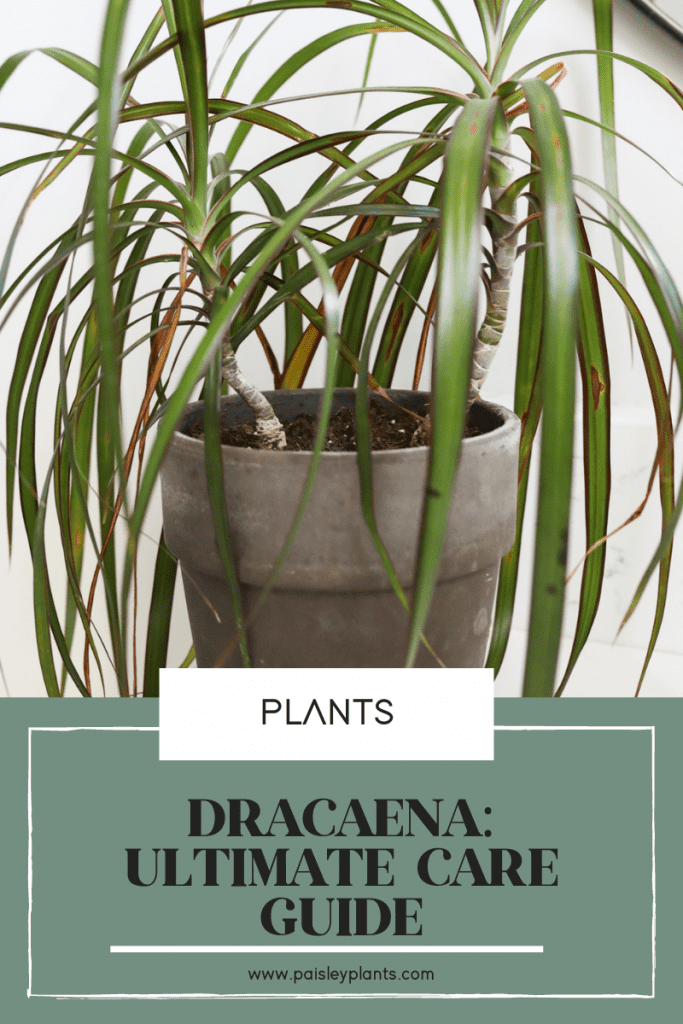
The Dracaena is native to a multitude of locations, ranging from South Asia, to the tropics of Africa, to even as far as Australia. Unfortunately for pet owners, the dracaena does contain saponins, which is a chemical compound that is toxic to both dogs and cats.
Dracaenas are easy to care for, and they tend to be very forgiving when it comes to their growing preferences. Let’s take a look at the dracaena’s preferred growing conditions:
Growing Preferences
Sun & Light
The dracaena enjoys bright indirect light. I would recommend keeping them in a warm room with a sheer curtain over the window. Please avoid giving the dracaena direct sunlight as it can cause damage to the leaves.
Dracaena plants can tolerate somewhat low light conditions but not getting enough light makes your plant slower to grower.
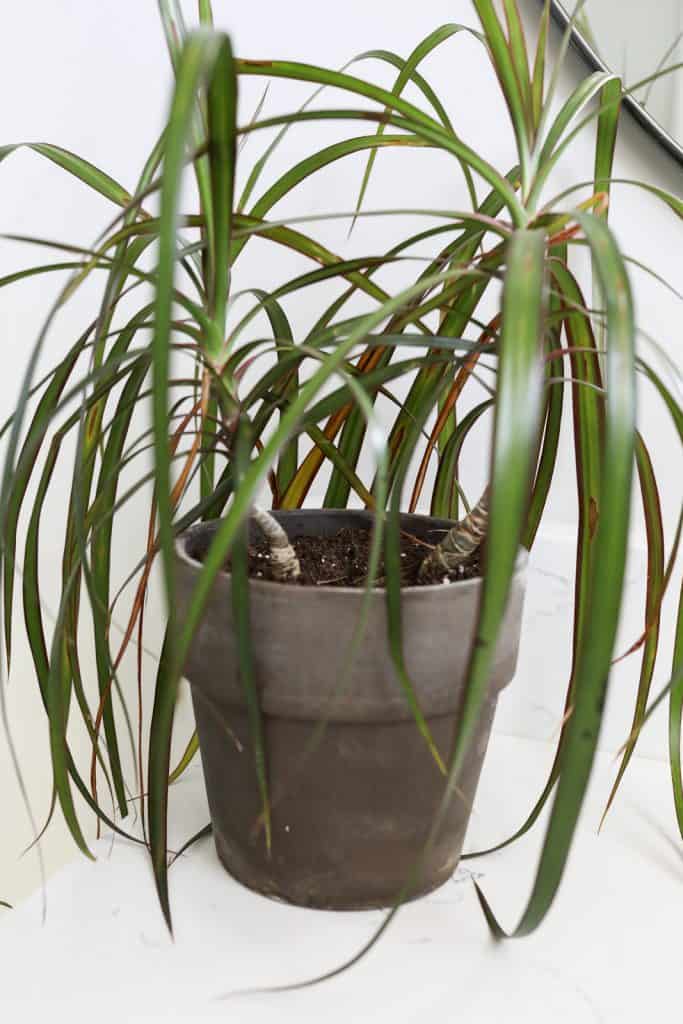
Soil Preference
The potting soil you select for your dracaena should be rich and well-draining, but with the ability to maintain steady moisture. Dracaena plants are rather forgiving when it comes to potting soil, and a standard houseplant mix from your local garden center can get the job done.
If you’re going the extra mile and opting to mix your own potting soil, I would recommend a 1:1:1 ratio of potting mix, coco peat, and vermiculite or coarse sand. The pH of the soil should be mildly acidic, somewhere in the 6.0 to 6.5 range.
Water Schedule
During the spring and summer, when the dracaena plant is actively growing, you should water your plant frequently; making sure to have moist soil at all times.
Use a little water during the winter, but still make sure to keep the soil moist; watering too much during the winter is extremely harmful to your plant. Dracaena are relatively drought-tolerant plants so less water is better than too much water.
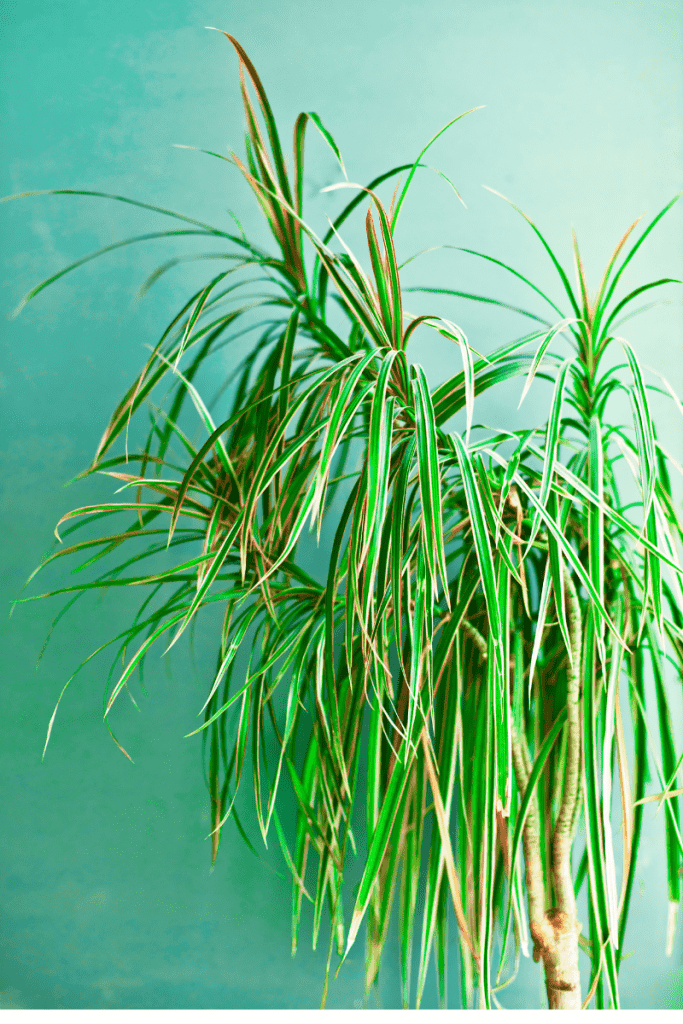
If you’re unsure as to whether or not it needs to be watered, I like to do the finger test! Simply stick your finger into the soil – if there’s wet soil you don’t need to water it, dry soil means it needs a drink of water!
If you choose to water dracaenas with tap water instead of distilled water, be sure to let it sit out for about 24 hours (or overnight). This helps neutralize your water which will prevent your leaf tips from turning brown.
If your plant is turning brown or yellow, you may want to switched to bottled water since they’re especially sensitive to the fluoride found in tap water.
Fertilizer
During the dracaena’s growing season (summer months), apply a liquid houseplant fertilizer every two weeks to your plant.
Temperature & Humidity
Dracaena plants love warm, humid conditions. Try to keep the room temperatures within the range of 65° F and 75° F. Certain varieties such as the dracaena draco can tolerate temperatures as cold as 50° F.
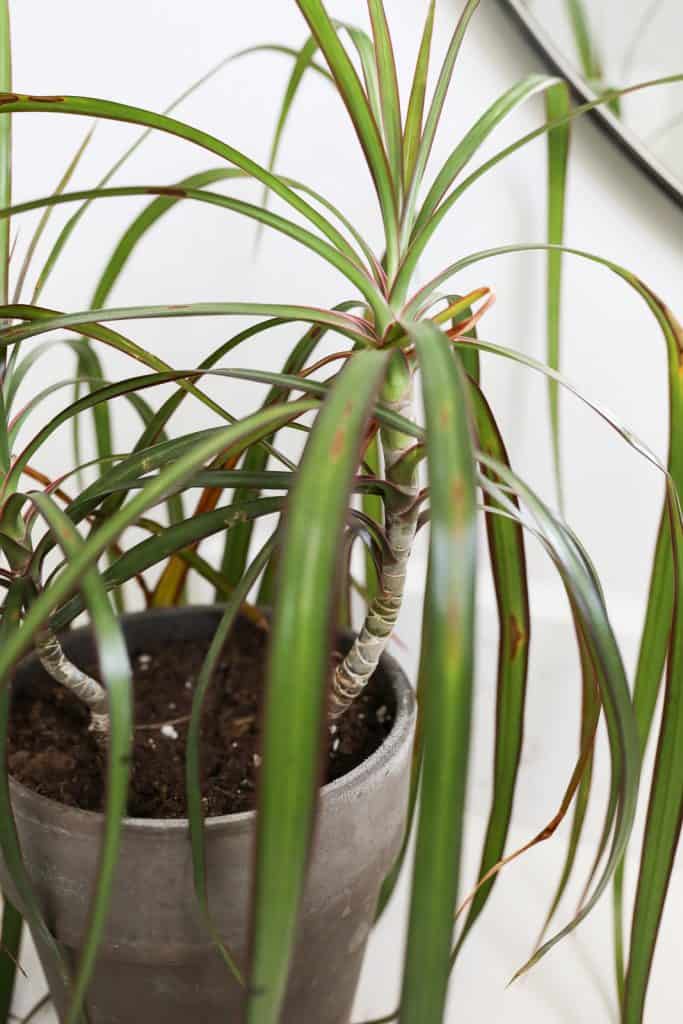
In addition, it is equally important to maintain a humid environment for your dracaena plant. If you feel that the room is mostly dry air as opposed to humid air, you can increase humidity levels by purchasing an air humidifier, regular misting, and/or sitting your dracaena plant atop a pebble tray filled with water.
Choosing a Container & Repotting
Like most house plants, dracaenas require a pot with ample drainage. Making sure that your plant pot has a drainage hole at the bottom allows for excess water to pass through; leaving the soil moist, but not completely soaked.
Plants that have poor drainage and no drainage holes are often more susceptible to root rot, which is a deadly disease caused by too much moisture in the soil.
Certain smaller dracaena varieties such as the goldieana or sanderana do not require frequent repotting because of their small size, and oftentimes can stay in the same pot for the majority of their lifespan.
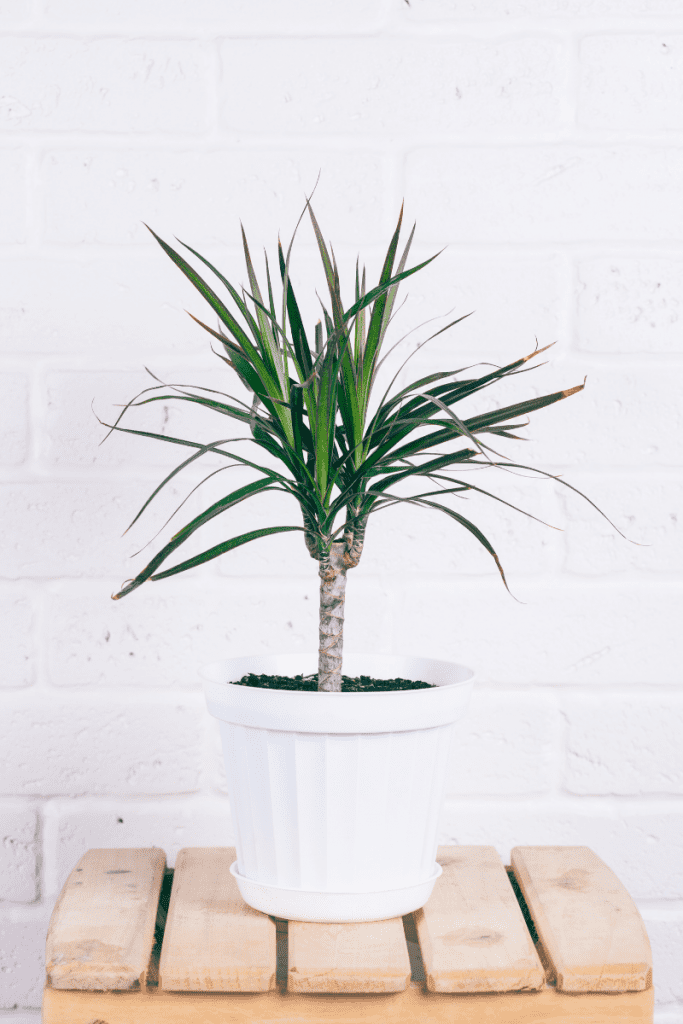
However, larger varieties of dracaenas greatly benefit from a biennial repotting. Once every two years, it is recommended to repot your plant into a larger pot that is slightly larger than the previous (about 1 or 2 inches larger).
How to Prune
Pruning is done for multiple reasons; it can help cut back dracaenas that are getting too big for the home, to encourage new growth and a fuller plant, and to clean up leaves that are damaged. Check out these helpful tips on pruning your dracaenas.
Always use sharp, sterilized clippers when pruning your dracaena plant. Using dull and/or contaminated shears can drastically heighten your dracaena’s risk of infection or disease. Prior to pruning, dip your shears in a solution of bleach and water to disinfect your shears and prevent disease down the road.
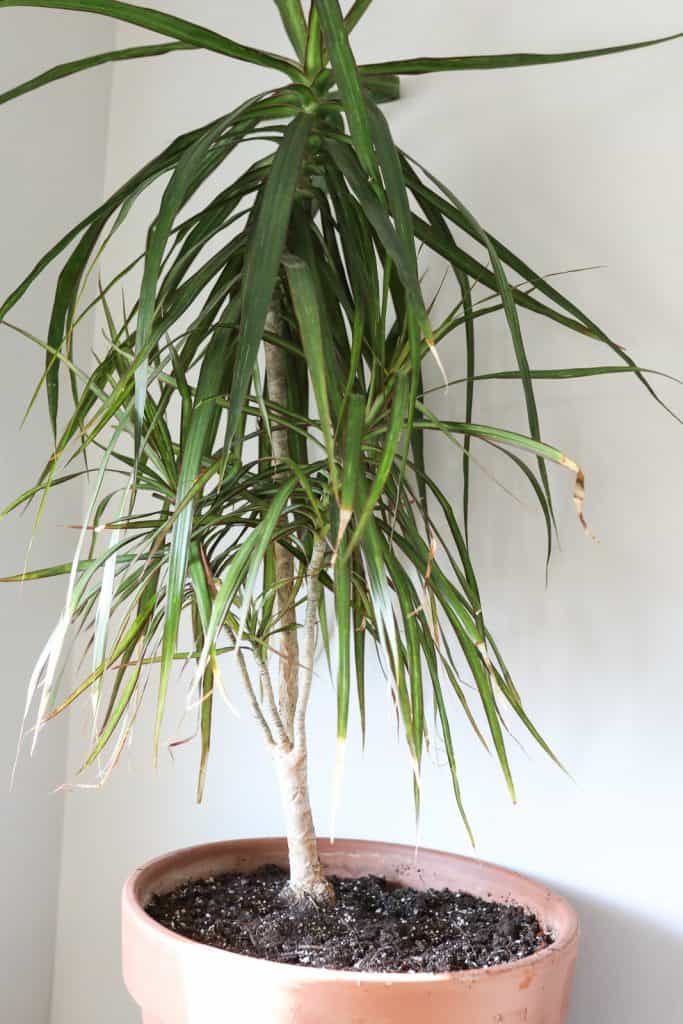
The ideal time to prune your dracaena is when it is in it’s active growing season (spring and summer). Do try to avoid trimming during its dormant season (fall and winter).
If you’re cutting down the main stalk of the dracaena, cut it at an angle to prevent possible infection. You can even use the stalk you just cut off to create a second dracaena plant with a simple process known as propagation. Propagating dracaenas are very straightforward, read on for further tips on how to propagate a dracaena plant.
How to Propagate
There are two methods to propagating dracaenas; both are very simple processes, so it is entirely up to your own discretion which method you select.
Propagating with Water
Take the crown from the dracaena that you have just pruned and place it in a cup of water (cut end goes in the water), trim off any bottom leaves that might be touching the water (this is to prevent infection).
Dracaena plants grow roots quickly when propagated in a warm location; you should see roots forming in just a few weeks. When these roots have reached between 1 to 2 inches long, you can transplant the cutting into a pot with soil.
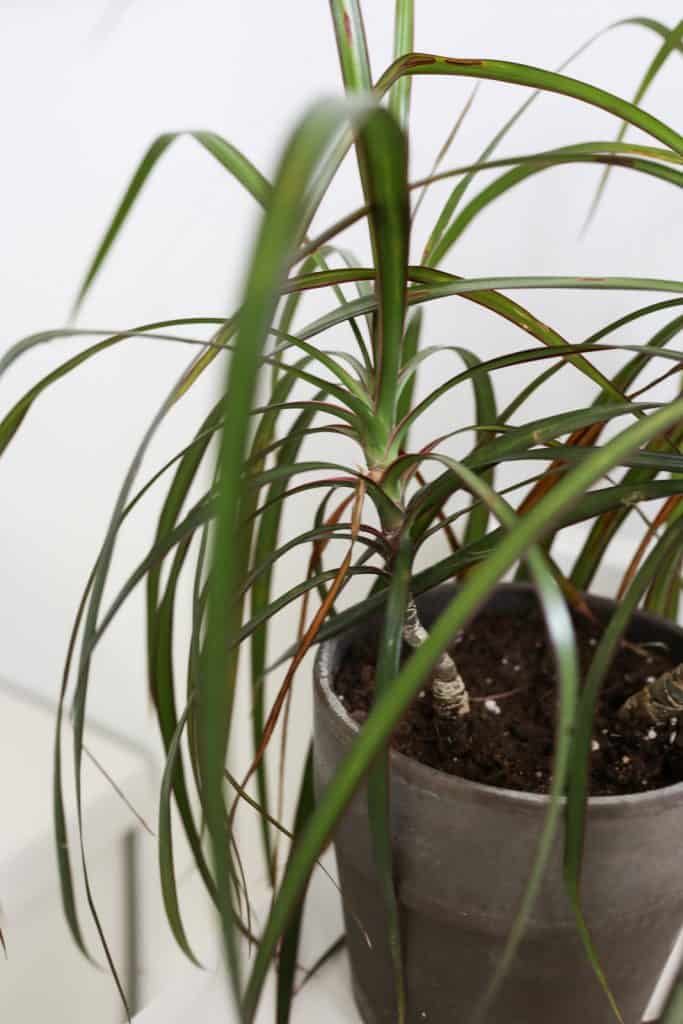
Propagating Directly Into Soil
This process is very similar to the previous method, though we’ll be skipping the part where we place the cutting into water. Dip the cut end of the crown in rooting powder (you can find this at a local gardening center), and directly transplant the cutting into the soil.
Roots should form quickly in a few weeks. You can tell if roots have started growing if you gently tug on the stalk of the dracaena and you’re met with some resistance.
Pests
One of the great benefits of owning a dracaena is that they are seldom attacked by pests that would otherwise destroy houseplants. On rare occasions, you might find yourself met with common household pests such as mealybugs or spider mites.
If you see any pests crawling around your dracaena, prune away any affected leaves (always check the undersides of the leaves!) and spritz your plant with an insecticidal soap or a horticultural oil (such as neem oil).
Disease
The most common killer amongst houseplants by far is root rot. Improper watering can be extremely easy with any plant, and that’s where root rot is just around the corner.
Too much water that sits in the plant’s container causes the root system to corrode and break down, which in turn, slowly kills your plant. Plants affected by root rot start to die off rapidly; yellowing or browning leaves will droop and your once-lively plant is on the brink of death.
Luckily, with early detection and quick action, you can revitalize an affected plant. Gently remove the plant from its container and inspect the roots. Healthy roots are firm in texture and have an off-white color, whereas rotted roots are brown and mushy to the touch.
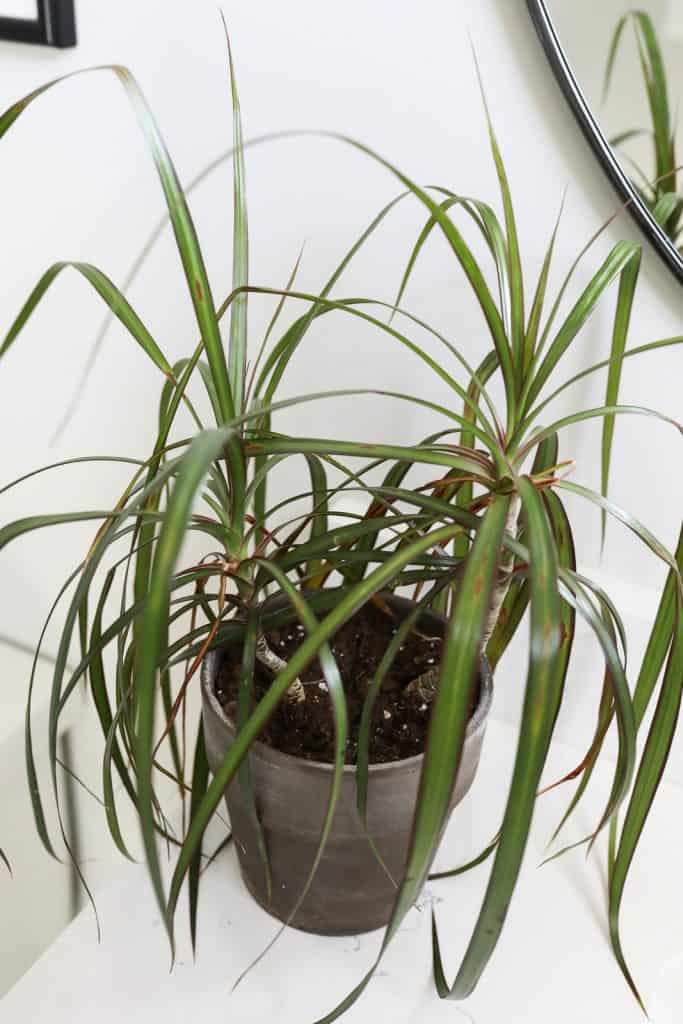
Take a sterile pair of sharp scissors and prune away at any signs of rot.
Once the pruning is complete, repot your plant in a clean container with fresh soil (do not reuse the same soil mix as before, dump out the soil entirely). Moisten the soil and make sure it’s not saturated.
Keep a close watch on your dracaena as it heals during this tumultuous time and make sure it is in a location with warm temperatures and humidity.
Help! My Dracaena…
Has dry patches on its leaves
Pale, dry patches on your dracaena leaves might indicate too much sunlight. Dracaenas love a
bright, yet indirect sunlight. Exposing dracaenas to direct sun causes these patches to appear on its leaves. Try moving your plant further from the window and see if this remedies the issue.
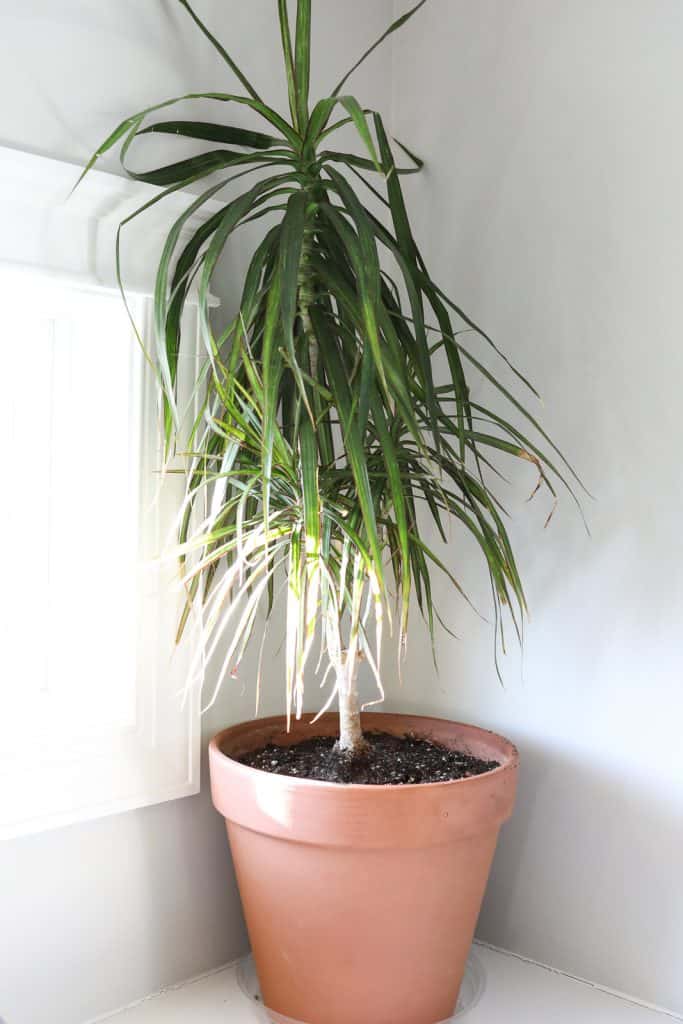
Has brown spots on its leaves
Brown spots usually indicate a lack of watering. Make sure the dracaena’s soil is moist consistently. On the flip side, the soil shouldn’t be saturated with standing water, as this opens up the chance of root rot.
Using a soil mix that contains peat moss and perlite both help maintain a perfect balance of moisture for your dracaena.
Is browning at the tips of its leaves
Brown tips is often a sign of inadequate temperature and/or humidity. Dracaenas are native to very hot, tropical regions of the planet, so try your best to replicate these conditions.
Try not to allow the room temperature to slip below 60° F, and give your tropical plant a little misting to keep them feeling humid.
In Conclusion
With its wide array of sizes and colors, the dracaena is an ideal houseplant as it can fit in anywhere. The best part of owning a dracaena is the low-maintenance care and forgiving nature towards normal household conditions. Owning a dracaena is like bringing a little bit of the tropics into your home!
If you want a closer look at 7 different types of dracaena, head to this post!

